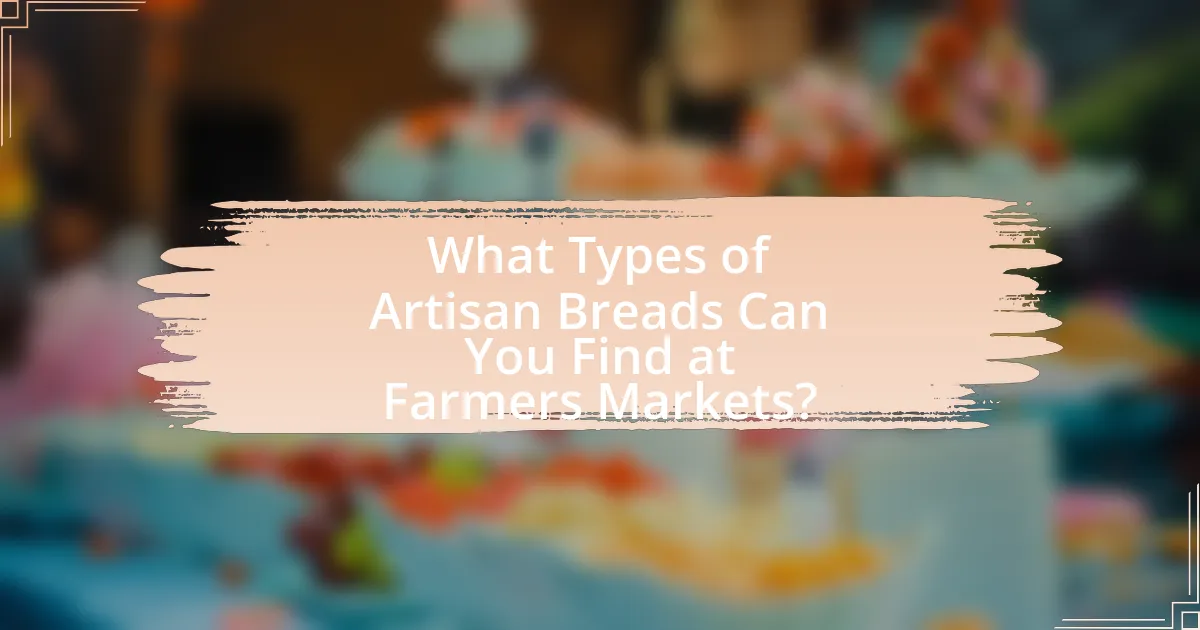Artisan breads are handcrafted loaves made using traditional methods and high-quality ingredients, gaining popularity at farmers markets due to their unique flavors and textures. This article provides a comprehensive guide to finding artisan breads at farmers markets, detailing how they differ from commercial breads, the typical ingredients used, and the baking processes that enhance their flavor. It also explores the benefits of purchasing artisan breads locally, the variety available, and tips for selecting and enjoying these products. Additionally, the article highlights how to engage with bakers, assess quality, and create meals using artisan breads, ensuring a rich experience for consumers.

What are Artisan Breads and Why are They Popular at Farmers Markets?
Artisan breads are handcrafted loaves made using traditional methods, often with high-quality ingredients and minimal processing. Their popularity at farmers markets stems from consumers’ increasing demand for locally sourced, fresh, and unique food products. Artisan breads typically feature distinctive flavors and textures due to the use of natural fermentation processes, such as sourdough, which enhances taste and digestibility. Additionally, farmers markets provide a direct connection between bakers and consumers, allowing for the appreciation of craftsmanship and the opportunity to support local economies. This combination of quality, flavor, and community engagement contributes to the strong appeal of artisan breads at these markets.
How do Artisan Breads differ from Commercial Breads?
Artisan breads differ from commercial breads primarily in their production methods and ingredients. Artisan breads are typically made using traditional techniques, such as long fermentation and hand shaping, which enhance flavor and texture. In contrast, commercial breads often utilize industrial processes, including the use of additives and preservatives, to ensure uniformity and extend shelf life. For example, artisan breads may contain only flour, water, salt, and natural leavening agents, while commercial breads frequently include dough conditioners and artificial flavors to speed up production and reduce costs. This fundamental difference in approach results in artisan breads having a more complex flavor profile and a crustier texture compared to the softer, more uniform characteristics of commercial breads.
What ingredients are typically used in Artisan Breads?
Artisan breads typically use four main ingredients: flour, water, salt, and yeast. Flour, often unbleached and whole grain, serves as the primary structure, while water hydrates the flour and activates the yeast. Salt enhances flavor and controls fermentation, and yeast is responsible for leavening the bread. These ingredients are combined in specific ratios to create a variety of textures and flavors, reflecting traditional baking methods that emphasize quality and craftsmanship.
How does the baking process of Artisan Breads enhance flavor?
The baking process of Artisan Breads enhances flavor through techniques such as long fermentation and high-temperature baking. Long fermentation allows for the development of complex flavors as yeast and bacteria break down sugars and produce organic acids, contributing to a tangy taste. High-temperature baking creates a Maillard reaction, which caramelizes sugars and proteins, resulting in a rich, nutty flavor and a desirable crust. These methods are rooted in traditional baking practices, which emphasize quality ingredients and time, leading to a superior flavor profile in the final product.
What makes Farmers Markets a great place to find Artisan Breads?
Farmers markets are a great place to find artisan breads due to their emphasis on local, handcrafted products. These markets typically feature bakers who prioritize quality ingredients and traditional baking methods, resulting in unique flavors and textures that mass-produced breads lack. Additionally, many artisan bakers at farmers markets use organic or locally sourced ingredients, which enhances the freshness and nutritional value of their breads. The direct interaction with bakers allows consumers to learn about the bread-making process and the specific ingredients used, fostering a deeper appreciation for the craft.
How do local bakers contribute to the variety of Artisan Breads available?
Local bakers significantly enhance the variety of artisan breads available by utilizing unique recipes, local ingredients, and traditional baking techniques. Each baker often specializes in specific types of bread, such as sourdough, ciabatta, or rye, which reflects their personal style and regional influences. For instance, a study by the American Bakers Association highlights that local bakers frequently incorporate seasonal produce and grains sourced from nearby farms, resulting in diverse flavor profiles and textures. This commitment to local sourcing not only supports the community but also fosters innovation in bread-making, leading to a rich assortment of artisan breads at farmers markets.
What are the benefits of buying Artisan Breads at Farmers Markets?
Buying artisan breads at farmers markets offers several benefits, including freshness, quality, and support for local economies. Artisan breads are typically made using traditional methods and high-quality ingredients, resulting in superior taste and texture compared to mass-produced options. Additionally, purchasing from local bakers fosters community relationships and helps sustain local businesses, contributing to the economic health of the area. Farmers markets also provide an opportunity to engage directly with bakers, allowing consumers to learn about the ingredients and baking processes, which enhances the overall purchasing experience.

How to Identify Quality Artisan Breads at Farmers Markets?
To identify quality artisan breads at farmers markets, examine the ingredients, texture, and aroma. Quality artisan breads typically contain minimal, high-quality ingredients such as flour, water, salt, and natural leavening agents, avoiding preservatives and additives. The texture should be crusty on the outside and soft on the inside, indicating proper fermentation and baking techniques. Additionally, a rich, inviting aroma signifies freshness and quality. These characteristics align with the standards set by organizations like the Bread Bakers Guild of America, which emphasizes the importance of traditional methods and quality ingredients in artisan bread production.
What should you look for when selecting Artisan Breads?
When selecting artisan breads, look for high-quality ingredients, such as organic flour, natural leavening agents, and minimal preservatives. Artisan breads are typically made using traditional methods, which enhance flavor and texture. For instance, breads that are naturally fermented often have a more complex taste and better digestibility due to the presence of beneficial bacteria. Additionally, examine the crust and crumb; a well-baked artisan bread should have a crispy crust and an open, airy crumb structure. These characteristics indicate proper fermentation and baking techniques, which are essential for authentic artisan bread.
How can you assess the freshness of Artisan Breads?
To assess the freshness of artisan breads, examine their crust, aroma, and texture. Fresh artisan breads typically have a crisp crust, a pleasant, yeasty aroma, and a soft, airy interior. The crust should feel firm and not overly soft or stale, indicating recent baking. Additionally, a fresh loaf will have a slight spring when pressed, showing that it retains moisture and has not dried out. These characteristics are essential indicators of quality and freshness in artisan breads.
What are the signs of high-quality ingredients in Artisan Breads?
High-quality ingredients in artisan breads are indicated by the use of organic flour, natural fermentation processes, and minimal additives. Organic flour ensures that the grains are grown without synthetic pesticides or fertilizers, which enhances the bread’s flavor and nutritional value. Natural fermentation, often achieved through sourdough methods, contributes to a complex taste and better digestibility. Additionally, the absence of artificial preservatives and fillers signifies a commitment to quality, as these ingredients can compromise the bread’s integrity and flavor.
How can you engage with bakers at Farmers Markets?
To engage with bakers at Farmers Markets, approach them with genuine interest in their products and ask questions about their baking process. Engaging in conversation about their ingredients, techniques, and inspirations fosters a connection and shows appreciation for their craft. Research indicates that personal interactions can enhance customer loyalty and satisfaction, as consumers often prefer to buy from vendors who share their passion and knowledge about their offerings.
What questions should you ask bakers about their Artisan Breads?
To understand the quality and characteristics of Artisan Breads, you should ask bakers specific questions such as: “What ingredients do you use?” This question helps identify the quality and source of the ingredients, which is crucial for Artisan Breads, as they often emphasize natural and organic components. Additionally, inquire about the fermentation process by asking, “How long do you ferment your dough?” A longer fermentation typically enhances flavor and texture, aligning with traditional Artisan methods. You should also ask, “What baking techniques do you employ?” This reveals the craftsmanship involved, as Artisan Breads often utilize methods like wood-fired baking or steam injection. Lastly, asking, “Do you have any signature breads or seasonal offerings?” can provide insight into the baker’s creativity and commitment to using local ingredients, which is a hallmark of Artisan baking.
How can you learn about the baking techniques used by local bakers?
You can learn about the baking techniques used by local bakers by attending workshops or classes offered by them. Many local bakers host events where they share their methods and recipes, providing hands-on experience. Additionally, engaging with bakers at farmers markets allows for direct conversations where you can ask questions about their techniques. Research indicates that community engagement in culinary practices enhances knowledge transfer, as seen in studies on local food systems.

What Types of Artisan Breads Can You Find at Farmers Markets?
Farmers markets typically feature a variety of artisan breads, including sourdough, ciabatta, baguettes, focaccia, and multigrain loaves. These breads are often made using traditional methods and high-quality ingredients, which enhances their flavor and texture. For instance, sourdough is known for its tangy taste due to natural fermentation, while ciabatta is recognized for its airy crumb and crispy crust. The presence of these diverse types of artisan breads at farmers markets reflects the growing demand for handcrafted, locally produced food items.
What are the most common varieties of Artisan Breads available?
The most common varieties of artisan breads available include sourdough, baguette, ciabatta, focaccia, and multigrain. Sourdough is characterized by its tangy flavor and chewy texture, resulting from natural fermentation. Baguettes are known for their crispy crust and soft interior, while ciabatta features a rustic appearance with a light, airy crumb. Focaccia is often topped with herbs and olive oil, providing a flavorful experience, and multigrain breads incorporate various grains and seeds for added nutrition and texture. These varieties are widely recognized in artisan bakeries and farmers markets, reflecting traditional baking methods and high-quality ingredients.
How do regional influences shape the types of Artisan Breads offered?
Regional influences shape the types of artisan breads offered by reflecting local ingredients, cultural traditions, and climate conditions. For instance, regions with abundant wheat production, such as the Midwest in the United States, typically feature breads like sourdough and whole grain loaves that utilize locally sourced grains. In contrast, coastal areas may emphasize breads that incorporate seafood or herbs, influenced by local culinary practices. Additionally, cultural heritage plays a significant role; for example, French regions are known for baguettes and brioche, while Italian regions favor ciabatta and focaccia, showcasing the historical baking techniques and preferences of those areas. This diversity in artisan breads is a direct result of the interplay between geography, local resources, and cultural identity.
What seasonal Artisan Breads should you look for throughout the year?
Throughout the year, you should look for specific seasonal artisan breads such as pumpkin bread in the fall, which incorporates fresh pumpkin and spices, and is popular during harvest festivals. In winter, seek out stollen, a traditional German bread filled with dried fruits and nuts, often enjoyed during the holiday season. Spring brings forth breads like rosemary focaccia, utilizing fresh herbs that are abundant during this time. Finally, summer is ideal for sourdough made with seasonal fruits like berries, enhancing its flavor profile. These seasonal breads reflect the ingredients available at different times of the year, making them a staple at farmers markets.
How can you pair Artisan Breads with other market offerings?
Artisan breads can be paired with various market offerings such as cheeses, charcuterie, and seasonal vegetables to enhance their flavors. For instance, a crusty sourdough complements sharp cheddar, while a nutty whole grain bread pairs well with creamy goat cheese. Additionally, artisan breads can serve as a base for bruschetta topped with fresh tomatoes and basil, or as a side to hearty soups made from local produce. These pairings not only elevate the dining experience but also promote the use of fresh, local ingredients, which is a key aspect of farmers market offerings.
What spreads and toppings complement different types of Artisan Breads?
Artisan breads pair well with a variety of spreads and toppings that enhance their unique flavors. For example, a crusty sourdough complements tangy spreads like cream cheese or herb-infused butter, while a nutty whole grain bread pairs excellently with almond butter or honey. A soft focaccia is ideal with olive oil and balsamic vinegar for dipping, and a sweet brioche can be enhanced with fruit preserves or whipped mascarpone. These combinations are supported by culinary traditions that emphasize the balance of flavors, such as the Mediterranean practice of pairing bread with olive oil and dips.
How can you create a meal using Artisan Breads from the market?
To create a meal using Artisan Breads from the market, select a variety of breads such as sourdough, ciabatta, or focaccia as the base. These breads can be used to make sandwiches, bruschetta, or served alongside soups and salads. For instance, layer fresh ingredients like roasted vegetables, meats, or cheeses between slices of artisan bread to craft a gourmet sandwich. Additionally, to make bruschetta, top toasted slices of artisan bread with diced tomatoes, basil, and olive oil. Artisan breads are known for their unique flavors and textures, which enhance the overall dining experience.
What are some tips for making the most of your Artisan Bread experience at Farmers Markets?
To make the most of your Artisan Bread experience at Farmers Markets, prioritize visiting early to ensure the best selection of freshly baked goods. Artisan breads are often made in limited quantities, and arriving early increases your chances of obtaining popular varieties before they sell out. Additionally, engage with the bakers to learn about their methods and ingredients, which can enhance your appreciation of the bread. Many bakers are passionate about their craft and can provide insights into the unique flavors and textures of their products. Lastly, consider sampling different breads to discover your preferences, as many vendors offer tastings that can guide your purchases.
How can you plan your visit to maximize your Artisan Bread selection?
To maximize your Artisan Bread selection at farmers markets, plan your visit during peak hours when vendors are most stocked. Arriving early ensures access to the freshest and widest variety of breads, as many artisan bakers sell out quickly. Additionally, researching participating vendors beforehand allows you to identify those specializing in artisan breads, increasing your chances of finding unique offerings. Many farmers markets provide vendor lists online, which can help you prioritize your visit.
What are the best practices for storing and enjoying Artisan Breads at home?
The best practices for storing and enjoying artisan breads at home include keeping them in a paper bag or a bread box to maintain their crust while preventing moisture loss. Artisan breads are best enjoyed fresh, ideally within the first few days of purchase, as they are made without preservatives. For longer storage, freezing is recommended; wrap the bread tightly in plastic wrap and then in aluminum foil to prevent freezer burn, allowing it to retain its flavor and texture. When ready to enjoy, thaw the bread at room temperature and reheat it in the oven for a few minutes to restore its crustiness. These methods ensure that the unique qualities of artisan breads are preserved and enjoyed to their fullest.